Paper Menu >>
Journal Menu >>
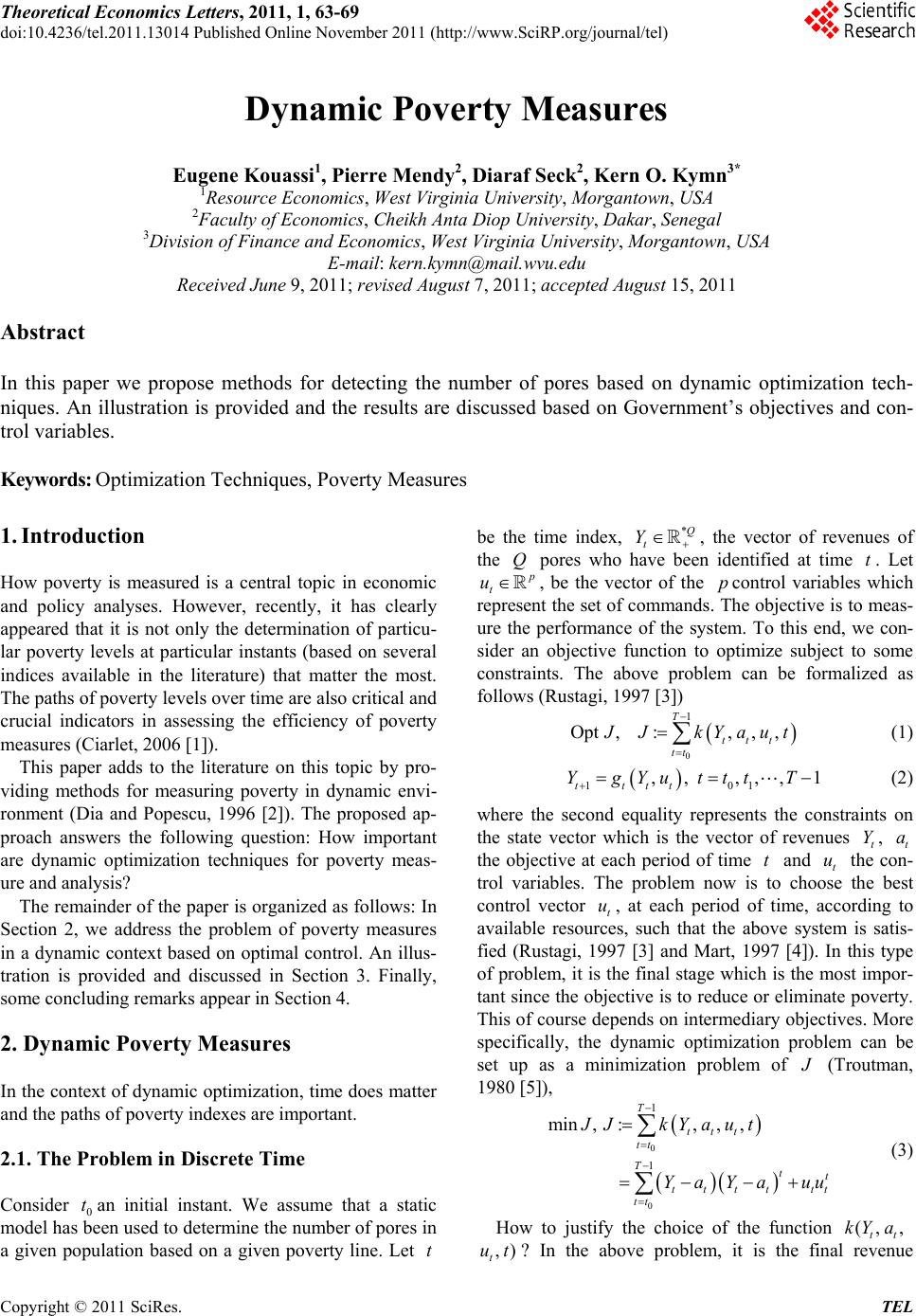 Theoretical Economics Letters, 2011, 1, 63-69 doi:10.4236/tel.2011.13014 Published Online November 2011 (http://www.SciRP.org/journal/tel) Copyright © 2011 SciRes. TEL Dynamic Poverty Measures Eugene Kouassi1, Pierre Mendy2, Diaraf Seck2, Kern O. Kymn3* 1Resource Economics, West Virginia University, Morgantown, USA 2Faculty of Economics, Cheikh Anta Diop University, Dakar, Senegal 3Division of Finance a nd Eco nomi c s, West Virginia University, Morgantown, USA E-mail: kern.kymn@mail.wvu.edu Received June 9, 2011; revised August 7, 2011; accepted August 15, 2011 Abstract In this paper we propose methods for detecting the number of pores based on dynamic optimization tech- niques. An illustration is provided and the results are discussed based on Government’s objectives and con- trol variables. Keywords: Optimization Techniques, Poverty Measures 1. Introduction How poverty is measured is a central topic in economic and policy analyses. However, recently, it has clearly appeared that it is not only the determination of particu- lar poverty levels at particular instants (based on several indices available in the literature) that matter the most. The paths of poverty levels over time are also critical and crucial indicators in assessing the efficiency of poverty measures (Ciarlet, 2006 [1]). This paper adds to the literature on this topic by pro- viding methods for measuring poverty in dynamic envi- ronment (Dia and Popescu, 1996 [2]). The proposed ap- proach answers the following question: How important are dynamic optimization techniques for poverty meas- ure and analysis? The remainder of the paper is organized as follows: In Section 2, we address the problem of poverty measures in a dynamic context based on optimal control. An illus- tration is provided and discussed in Section 3. Finally, some concluding remarks appear in Section 4. 2. Dynamic Poverty Measures In the context of dynamic optimization, time does matter and the paths of poverty indexes are important. 2.1. The Problem in Discrete Time Consider 0an initial instant. We assume that a static model has been used to determine the number of pores in a given population based on a given poverty line. Let be the time index, t t *Q t Y , the vector of revenues of the pores who have been identified at time . Let Qt p t, be the vector of the control variables which represent the set of commands. The objective is to meas- ure the performance of the system. To this end, we con- sider an objective function to optimize subject to some constraints. The above problem can be formalized as follows (Rustagi, 199 7 [3] ) up , Opt ,,, ttt 0 1 :T tt J Jk Yaut (1) 1 ,, tt Yu 01 ,,, tt Yg ttT t1 (2) where the second equality represents the constraints on the state vector which is the vector of revenues t, t the objective at each period of time and t the con- trol variables. The problem now is to choose the best control vector t, at each period of time, according to available resources, such that the above system is satis- fied (Rustagi, 1997 [3] and Mart, 1997 [4]). In this type of problem, it is the final stage which is the most impor- tant since the objective is to reduce or eliminate poverty. This of course depends on intermediary objectives. More specifically, the dynamic optimization problem can be set up as a minimization problem of Y a t u u J (Troutman, 1980 [5]), min ,:, t tt tt tt JJ t Ya uu , tt au 0 0 1 1 , T tt T tt tt kY Ya (3) How to justify the choice of the function ? In the above problem, it is the final revenue (,kY , tt a , t ut) 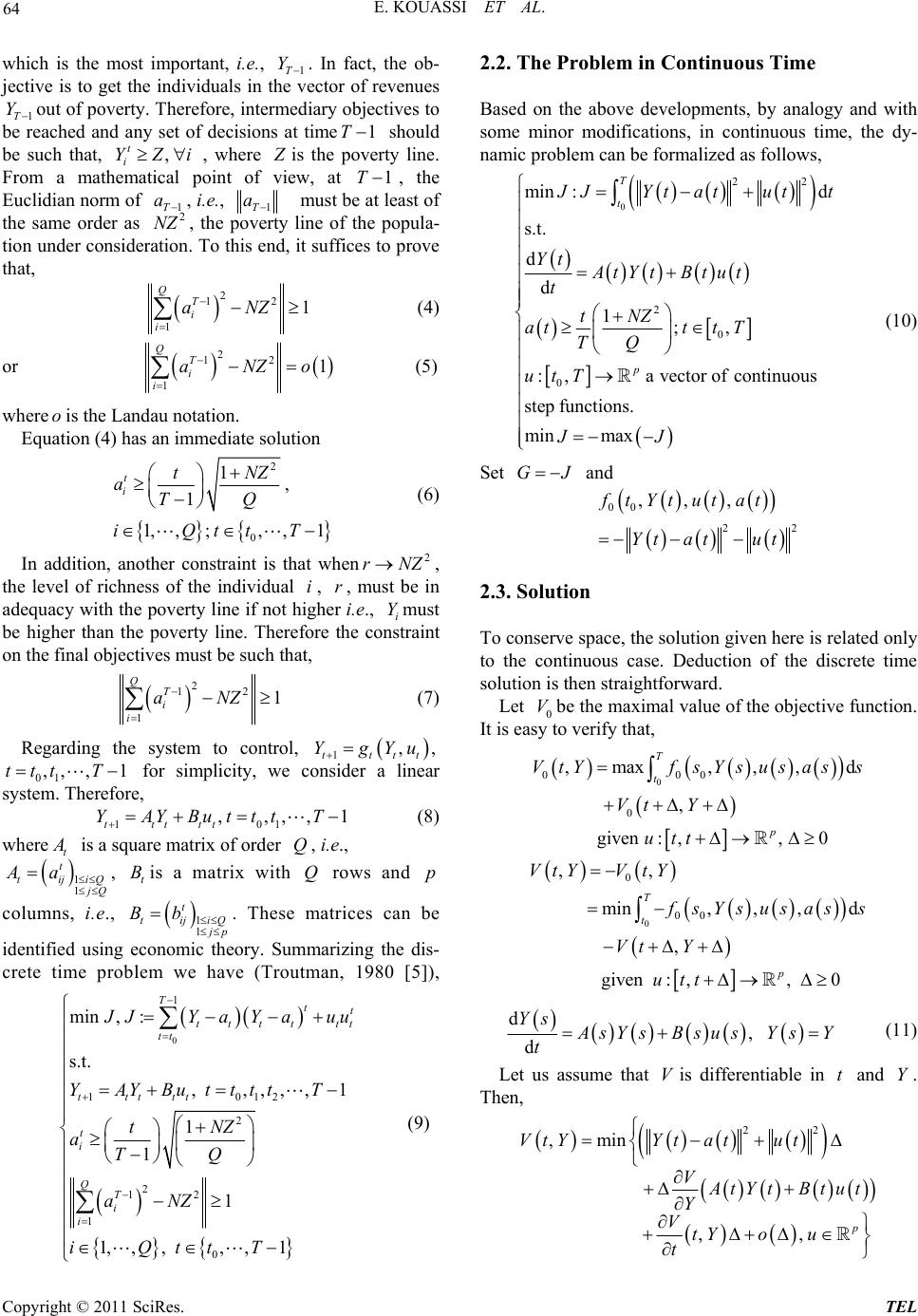 E. KOUASSI ET AL. 64 which is the most important, i.e., 1T. In fact, the ob- jective is to get the individuals in the vector of revenues 1Tout of poverty. Therefore, intermediary objectives to be reached and any set of decisions at time should be such that, , where Y Y1T , t i YZi Z is the poverty line. From a mathematical point of view, at 1T , the Euclidian norm of , i.e., 1T a1 T must be at least of the same order as , the poverty line of the popula- tion under consideration. To this end, it suffices to prove that, a 2 NZ 2 12 1aNZ 1 Q i i T (4) or o 2 12 1aNZ 1 QT i i (5) whereois the Landau notation. Equation (4) has an immediate solution 1 1, ,iQ 2 0 1, ;, ,1 t itNZ aTQ ttT r r (6) In addition, another constraint is that when, the level of richness of the individual , , must be in adequacy with the poverty line if not higher i.e., imust be higher than the poverty line. Therefore the constraint on the final objectives must be such that, 2 NZ iY 2 T i12 1 1 Q i aNZ (7) Regarding the system to control, ,,Yu 1tt 1 1T tt Yg 01 for simplicity, we consider a linear system. Therefore, ,, ,1t Ttt 1ttt Y 0 ,,,, tt YAButtt (8) where t A is a square matrix of order , i.e., Q 1 1iQtij t j Q Aa , is a matrix with Q rows and columns, i.e., t B p t ti1 1iQ j j p Bb. These matrices can be identified using economic theory. Summarizing the dis- crete time problem we have (Troutman, 1980 [5]), 0 1 2 12 1 1 , T tt t 10 1 2 1 0 min ,: s.t. ,,,,, 1 1, ,, ,1 t tttt tttt t i QT i i 2 1 t tt J JY YB aN aYa YA utttt tNZ aTQ Z iQttT uu T (9) 2.2. The Problem in Continuous Time Based on the above developments, by analogy and with some minor modifications, in continuous time, the dy- namic problem can be formalized as follows, 0 22 2 0 0 min :d s.t. d d 1;, :,avector ofcontinuous step functions. min max T t p J JYtatut Yt AtYt Btut t tNZ atttT TQ utT JJ t (10) Set GJ and 00 22 ,,,ftYtutat Yt atut 2.3. Solution To conserve space, the solution given here is related only to the continuous case. Deduction of the discrete time solution is then straightforward. Let 0be the maximal value of the objective fun ction. It is easy to verify that, V 0 000 0 ,max,,, d , given: ,,0 T t p VtYfsYsusas s Vt Y utt 0 0 00 ,, min,, ,d , given: ,,0 T t p VtYV tY f sYsus ass Vt Y utt d, d Ys A sY sBsusYsY t (11) Let us assume that is differentiable in and Y. Then, Vt 22 ,min ,,p VtYYtatut V A tYt Btut Y VtYo u t Copyright © 2011 SciRes. TEL 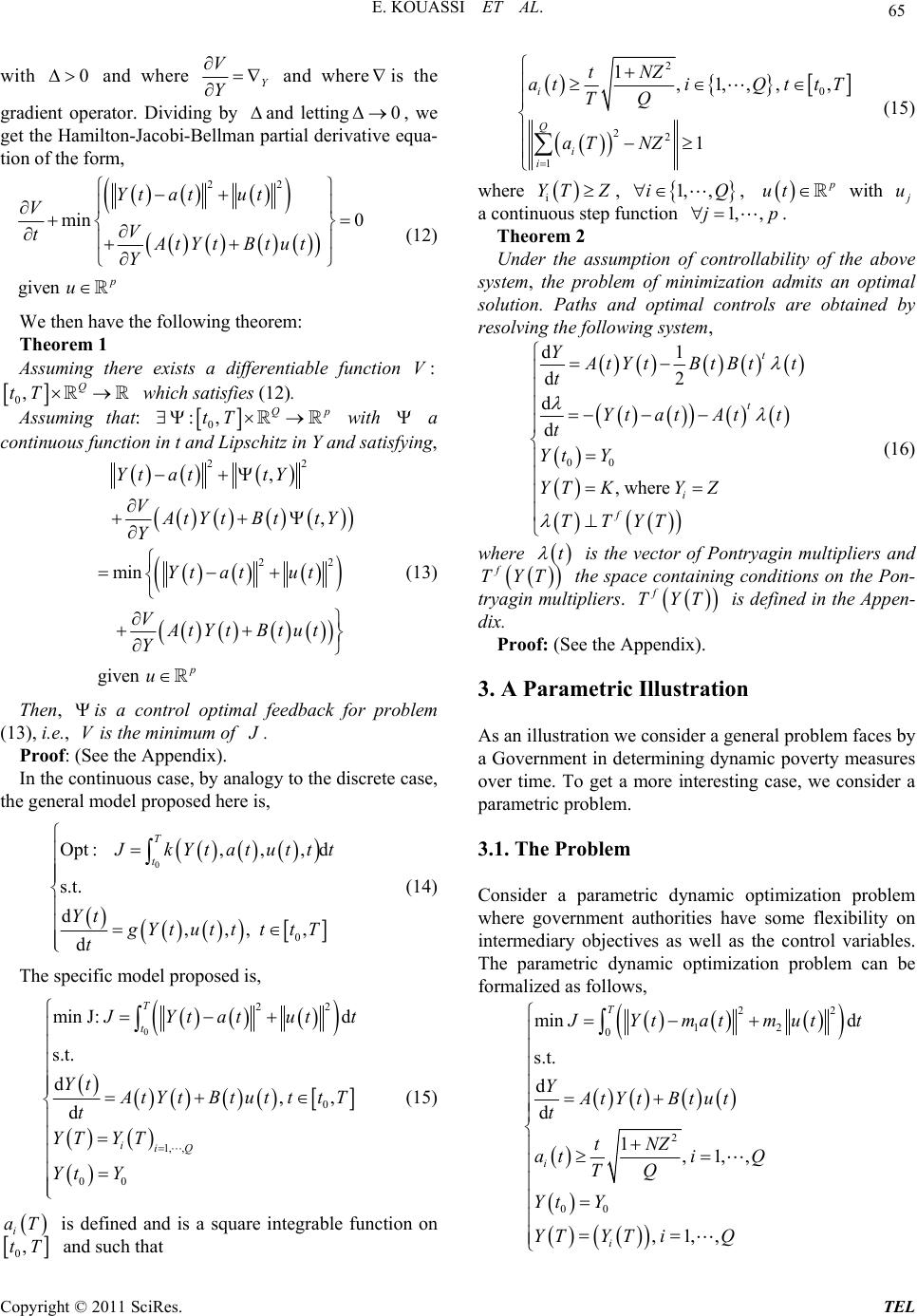 65 E. KOUASSI ET AL. with and where 0 Y V Y and where is the gradient operator. Dividing by and letting, we get the Hamilton-Jacobi-Bellman partial derivative equa- tion of the form, 0 22 min 0 given p Yt atut VV tAtYt Btut Y u (12) We then have the following theorem: Theorem 1 Assuming there exists a differentiable function :V 0,Q tT which satisfies (12). Assuming that: 0 :, Q tT p with a continuous function in t and Lipschitz in Y and satisfying, 22 22 , , min given p Yt attY V A tYt BttY Y Yt atut VAtYtBtut Y u (13) Then, is a control optimal feedback for problem (13), i.e., is the minimum of V J . Proof: (See the Appendix). In the continuous case, by analogy to the discrete case, the general model proposed here is, 0 0 Opt :,,,d s.t. d,,,, d T t J kYt at ut t t Yt g Yt ut tttT t (14) The specific model proposed is, 0 22 0 1, , 00 min J : d s.t. d,, d T t iiQ J Yt atutt Yt A tYtBtutttT t YT YT Yt Y (15) i aT is defined and is a square integrable function on 0,tT and such that 2 0 22 1 1,1,,,, 1 i Q i i tNZ atiQttT TQ aT NZ (15) where i YT Z, 1, ,iQ , p ut with j u a continuous step function 1, ,jp . Theorem 2 Under the assumption of controllability of the above system, the problem of minimization admits an optimal solution. Paths and optimal controls are obtained by resolving the following system, 00 d1 d2 d d ,where t t i f Y A tYtBtBt t t Yt atAtt t Yt Y YTKYZ TTYT (16) where t is the vector of Pontryagin multipliers and T f TY the space containing conditions on the Pon- tryagin multipliers. f TYT is d efined in the Appen- dix. Proof: (See the Appendix). 3. A Parametric Illustration As an illustration we consider a general problem faces by a Government in determining dynamic poverty measures over time. To get a more interesting case, we consider a parametric problem. 3.1. The Problem Consider a parametric dynamic optimization problem where government authorities have some flexibility on intermediary objectives as well as the control variables. The parametric dynamic optimization problem can be formalized as follows, 22 12 0 2 00 min d s.t. d d 1,1,, ,1,, T i i J Ytmatm utt YAtYtBtut t tNZ ati Q TQ Yt Y YTYT iQ Copyright © 2011 SciRes. TEL 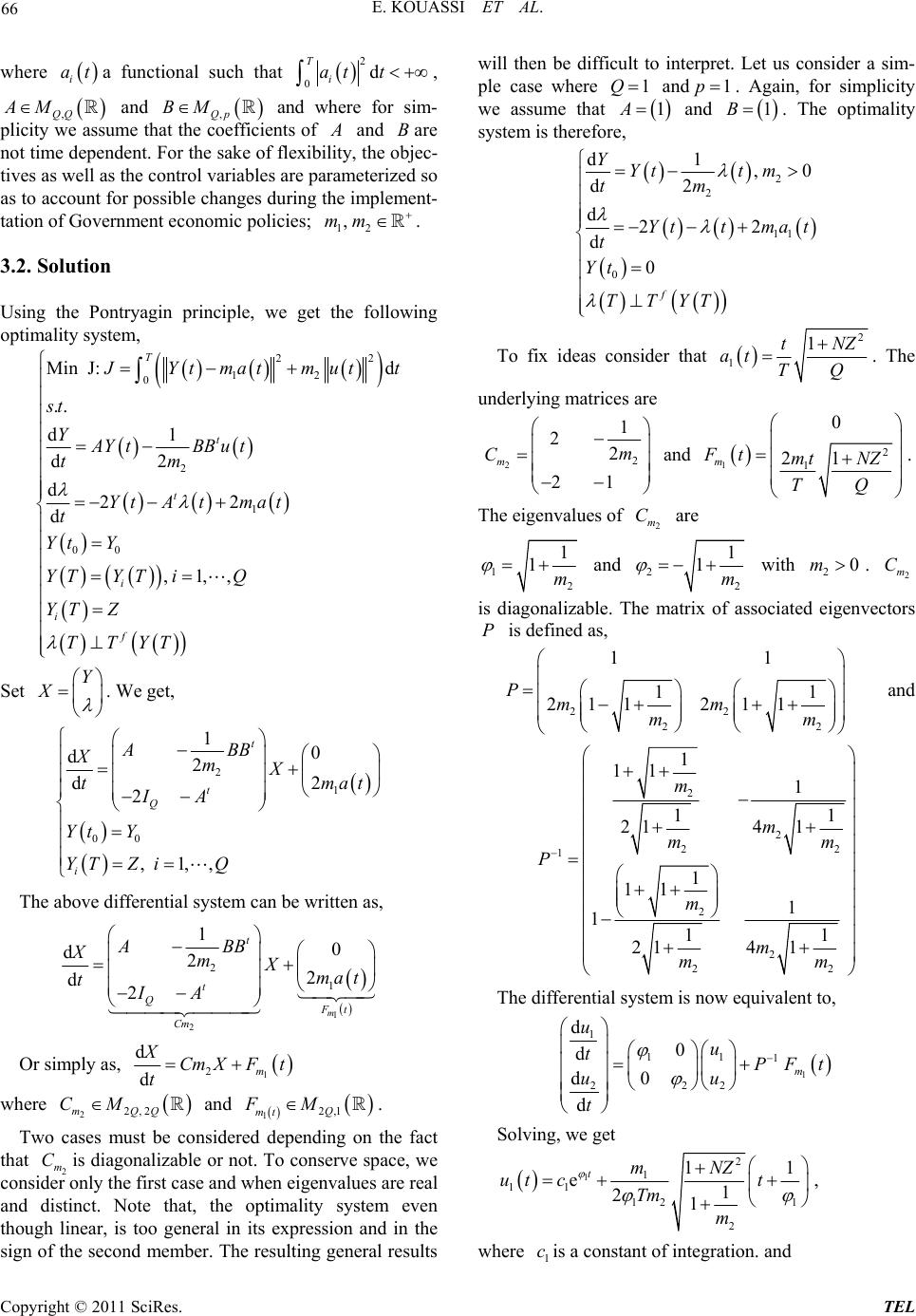 E. KOUASSI ET AL. 66 where a functional such that i at 2 0d T i att , ,QQ AM and ,Qp BM and where for sim- plicity we assume that the coefficients of A and Bare not time dependent. For the sak e of flexibility, the obje c- tives as well as the control variables are parameterized so as to account for possible changes during the implement- tation of Government economic policies; 12 ,mm . 3.2. Solution Using the Pontryagin principle, we get the following optimality system, 22 12 0 2 1 00 Min J: d .. d1 d2 d22 d ,1,, T t t i i f J Ytmatm utt st YAYtBBut tm YtA tmat t Yt Y YTYT iQ YTZ TTYT Set Y X . We get, 2 1 00 10 d22 d2 ,1,, t t Q i ABB XmXma t tIA Yt Y YTZ iQ The above differential system can be written as, 1 2 2 1 10 d22 d2 m t t QFt Cm ABB XmXma t tIA Or simply as, 1 2 d dm XCmXFt t where and . 22,2mQQ CM 12,1Q mt FM Two cases must be considered depending on the fact that 2 mis diagonalizable or not. To conserve space, we consider only the first case and when eigenvalues are real and distinct. Note that, the optimality system even though linear, is too general in its expression and in the sign of the second member. The resulting general results will then be difficult to interpret. Let us consider a sim- ple case where C 1Q and. Again, for simplicity we assume that 1p 1A and . The optimality system is therefore, 1B 00 f Yt Yt TT 2 22 t m t m T 2 11 d1 ,0 d2 d d Y tm at t Yt Y To fix ideas consider that 2 1tNZ TQ 1 at. The underlying matrices are 22 1 2 1 m 2 2 m C and 12 m Ft2 1 0 1 mt NZ TQ . The eigenvalues of are 2 m C 12 1 1m and 2 1 1m 2 with . is diagonalizable. The matrix of associated eigenvectors is defined as, 20m2 m C P 22 22 11 11 211 211 Pmm mm and 2 2 22 1 2 2 22 1 11 1 11 214 1 1 11 1 111 214 1 m m mm P m m mm The differential system is now equivalent to, 1 1 1 11 2 22 d0 d0 d d m uu tPFt uu t Solving, we get 1 2 1 11 12 1 2 11 e1 21 tmNZ ut ct Tm m , where is a constant of integration. and 1 c Copyright © 2011 SciRes. TEL 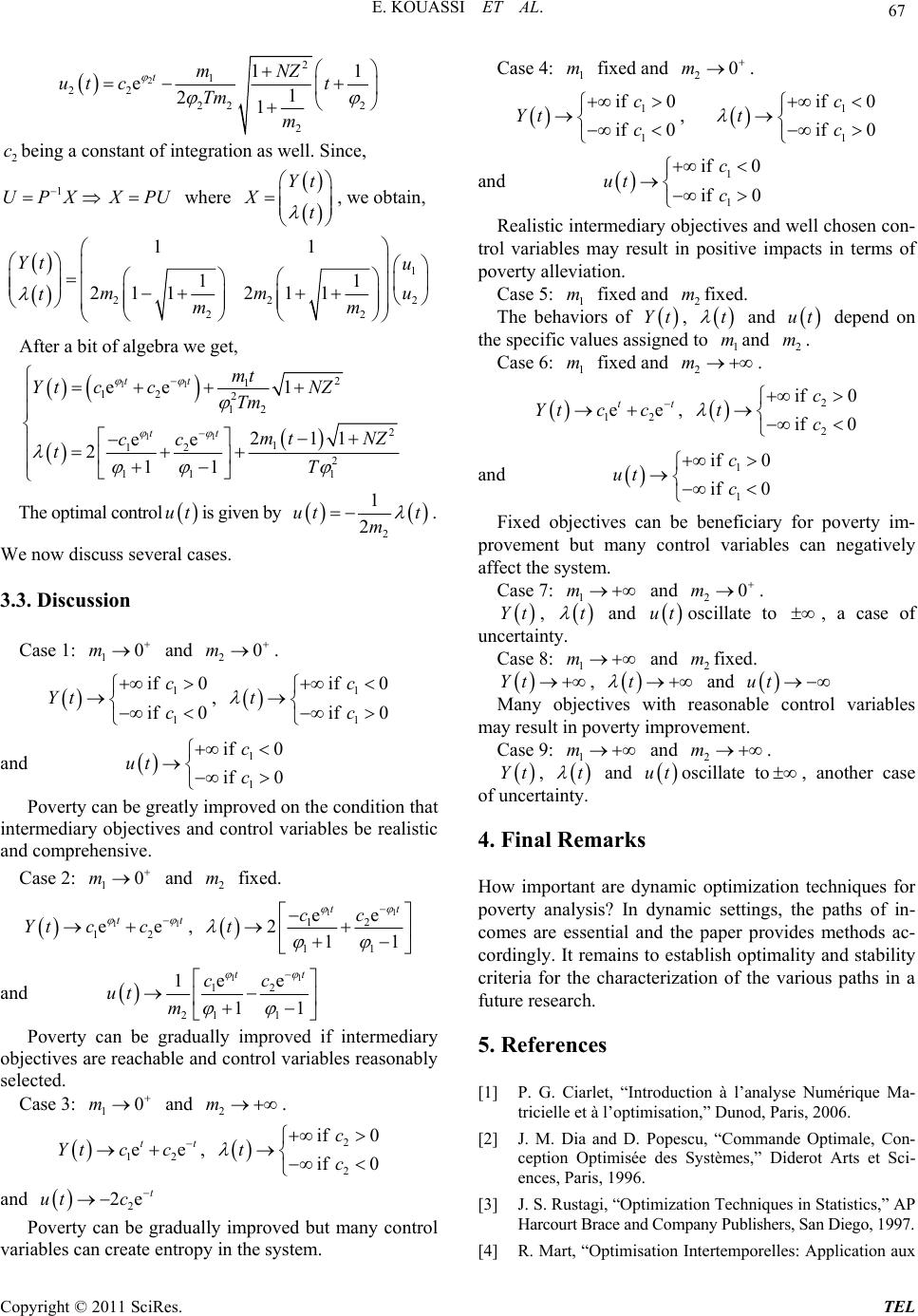 67 E. KOUASSI ET AL. 2 2 1 22 22 2 2 11 e1 21 tmNZ ut ct Tm m 2 cbeing a constant of integration as well. Since, 1 UPX X PU where , we obtain, Yt Xt 1 22 2 22 11 11 211 211 Yt u mm u tmm After a bit of algebra we get, 11 11 2 1 12 2 12 2 1 12 2 11 1 ee1 211 ee 211 tt tt mt Yt ccNZ Tm mt NZ cc tT The optimal controlis given by ut 2 1 2 ut t m . We now discuss seve ral cases . 3.3. Discussion Case 1: and . 10m 20m 1 1 if 0 if 0 c Yt c , 1 1 if 0 if 0 c tc a nd 1 1 if 0 if 0 c ut c Poverty can be greatly improved on the condition that intermediary objectives and control variables be realistic and comprehensive. Case 2: and fixed. 10m 2 m 11 12 ee tt Yt cc , 11 12 11 ee 211 tt cc t and 11 12 211 ee1 11 tt cc ut m Poverty can be gradually improved if intermediary objectives are reachable and control variables reasonably selected. Case 3: and . 10m 2 m 12 ee tt Ytcc , 2 2 if 0 if 0 c tc and 2 2e t utc Poverty can be gradually improved but many control variables can create entropy in the system. Case 4: fixed and . 1 m20m 1 1 if 0 if 0 c Yt c , 1 1 if 0 if 0 c tc a nd 1 1 if 0 if 0 c ut c Realistic intermediary objectives and well chosen con- trol variables may result in positive impacts in terms of poverty alleviation. Case 5: fixed and fixed. 1 The behaviors of m2 m Yt, and depend on the specific values assigned to and . t 1 m ut 2 m Case 6: fixed and . 1 m2 m 12 ee tt Yt c c , 2 2 if 0 if 0 c tc a nd 1 1 if 0 if 0 c ut c Fixed objectives can be beneficiary for poverty im- provement but many control variables can negatively affect the system. Case 7: and . 1 m 20m Yt, t and ut oscillate to , a case of uncertainty. Case 8: and fixed. 1 m 2 m Yt, t and ut Many objectives with reasonable control variables may result in poverty improvement. Case 9: and . 1 m 2 m Yt , t and utoscillate to, another case of uncertainty. 4. Final Remarks How important are dynamic optimization techniques for poverty analysis? In dynamic settings, the paths of in- comes are essential and the paper provides methods ac- cordingly. It remains to establish optimality and stability criteria for the characterization of the various paths in a future research. 5. References [1] P. G. Ciarlet, “Introduction à l’analyse Numérique Ma- tricielle et à l’optimisation,” Dunod, Paris, 2006. [2] J. M. Dia and D. Popescu, “Commande Optimale, Con- ception Optimisée des Systèmes,” Diderot Arts et Sci- ences, Paris, 1996. [3] J. S. Rustagi, “Optimization Techniques in Statistics,” AP Harcourt Brace and Company Publishers, San Diego, 1997. [4] R. Mart, “Optimisation Intertemporelles: Application aux Copyright © 2011 SciRes. TEL  E. KOUASSI ET AL. Copyright © 2011 SciRes. TEL 68 Modèles Macroéconomiques,” Economica, Paris 1997. [5] M. Troutman, “Calculus of Variations with Elementary Convexity,” Springer-Verlag, New York, 1980. where ** ** ,, , Y D tYtVtYt A tY tBttY t Appendix: Theorems and Proofs Theorem 1 Let 0,ttT, and Q Y 00 :, p utTbe a vec- tor of functions which represents control variables and 0 Y the solution to, We have, ** 0 ** * ** 0 ** * 0,,, ,, min,,, ,, Y Y VftYt tYt t VtYtAtYtBttYt ftYttYt VtY tAtY tBttY t . 00 . 00 0 ,, YAYBu YtYt T . Let * Y be the solutio n to, given p u .** .*00 0 ,, YAYBu Yt YtT * Thus, ** 0 ** 0 ** * ,,, ,,, ,, Y ftYttYt VftYttYt t VtYtAtYtBttYt where * ,uY * . The assumption on insures the existence of the solution to the above system. To show that is an optimal feedback control, we need to prove that, 0 0 22 ** 22 *0 d d T t T t Yt atutt Yt atutt Hence, 0 ** 00 ** 0 ,, ,,, T t VTY TVtYt d f tY ttY tt Set, 22 ** ** 0,, f tY t utY tatut and On the other hand, 22 ** 00 0 ,,ftYtutYt atut On the one hand, 0 ** * 00 d ,,, d T t V VTYTVtYttY tt t d * ** * d d,, , dd Y Yt VV tYttYt VtYt tt 0 0 0000 0 00 0 ,, d,d d ,d ,d d T t T Y t VTY TVtYt VtY tt t VtY tYt VtY tt tt t We can immediately notice that p u, and *** d d Yt A tYtBtu t t where . Since by assumption, * ,uttYt * * 0 0 ,, min, , , Y ftYt D ftYtut VtYtAtYt Btut 0 00 0 0 ** 0 * * d ,,, d d min, ,,d ,,, d ,,given d Y Y p Y Yt ftYtutVtYt t Yt ftYt utVtYtt ftYt tYt Yt VtY tu t Hence, 0 000 * 00 ,, ,, d T t VTY TVtYt 0 f tY tutt given p u 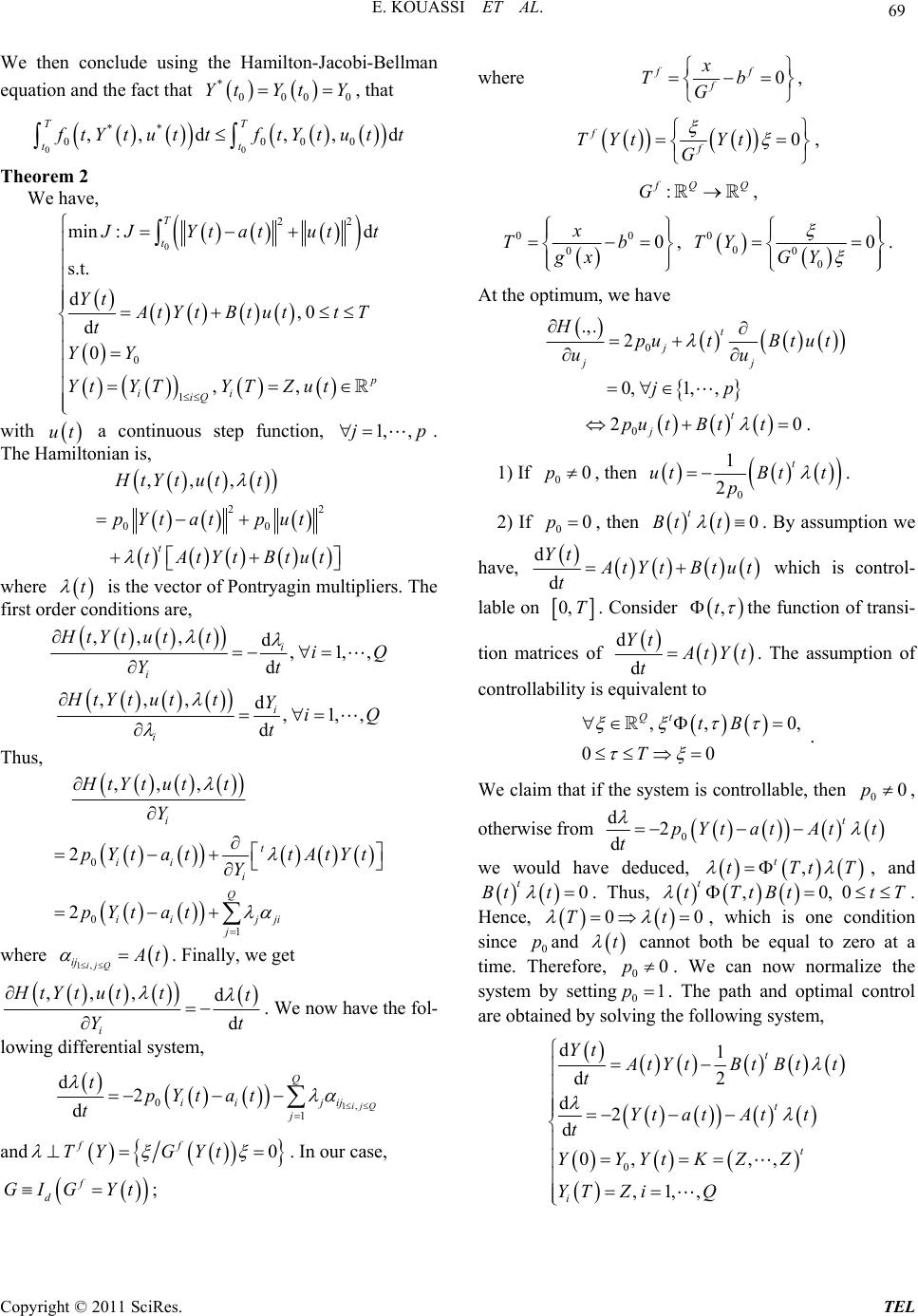 69 E. KOUASSI ET AL. We then conclude using the Hamilton-Jacobi-Bellman equation and the fact that *000 Yt Yt Y 0 0 d , that 00 ** 000 ,, d,, TT tt f tYtu ttf tYtu tt Theorem 2 We have, 0 22 0 1 min :d s.t. d,0 d 0 ,, T t p ii iQ J JYtatut Yt t A tYtBtuttT t YY YtYTYT Zut with a continuous step function, . The Hamiltonian is, ut 1, ,jp 22 00 ,,, t HtYt utt pYtatput tAtYtBtut where is the vector of Pontryagin multipliers. The first order conditions are, t ,,, d,1,, di i HtYt uttiQ Yt ,,,d,1,, di i HtYt uttYiQ t Thus, 0 01 ,,, 2 2 i t ii i Q ii jji j HtYt utt Y pYt attAtYt Y pYt at where 1,ijQ ij A t . Finally, we get ,,,d d i HtYt uttt Yt . We now have the fol- lowing differential system, 1, 01 d2 dij Q Q ii jij j tpYt at t and 0 ff TY GYt . In our case, ; f d GIGYt w here 0 ff f x Tb G , 0 ff TYtYt G , : f QQ G, 00 00 x Tb gx , 0000 0TY GY . At the optimum, we have 0 .,. 2 0,1, , t j jj HputBt u t uu jp 0 20 t j putB tt . 1) If 00p , then 0 1 2 t utBtt p . 2) If 00p , then . By assumption we have, 0 t Bt t d d Yt A tYt Btut t which is control- lable on 0, T. Consider ,t the function of transi- tion matrices of Ytd d A tYt t. The assumption of controllability is equivalent to ,, 00 Qt tB T 0, . We claim that if the system is controllable, then 00p , otherwise from t 0 d2 d t pYtatAt t we would have deduced, , t tTt T, and 0 t Bt t . Thus, . Hence, 0t ,0, t tTtBtT 0T0t , which is one condition since and 0 p t 0 p cannot both be equal to zero at a time. Therefore, 0 . We can now normalize the system by setting0 p1 . The path and optimal control are obtained by solving the following system, 0 d1 d2 d2 d 0, ,, ,1,, t t t i Yt A tYtBt Btt t Yt atAtt t YYYtKZZ YT ZiQ Copyright © 2011 SciRes. TEL |

